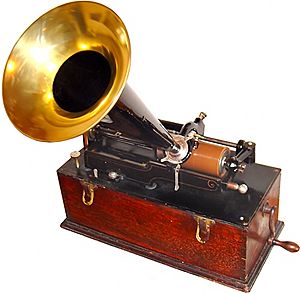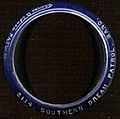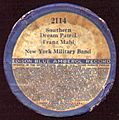Phonograph cylinders were the very first way people could record and play back sounds! Imagine being able to listen to music or voices whenever you wanted – these cylinders made that possible a long time ago. People often just called them "records" back then.

Edison wax cylinder phonograph from around 1899
They were hollow tubes with a special audio recording carved into their outside surface. To hear the sound, you would play them on a machine called a mechanical cylinder phonograph. In the 1910s, a new system using flat disc records became more popular and eventually replaced cylinders.
You can sometimes find these old cylinders and the machines that played them in local museums. They are a cool part of history!
Images for kids
-
Two Edison cylinder records (left and right) and their cylindrical cardboard boxes (center)
-
Brown wax cylinders showing various shades (and mold damage)
-
Paper record slip from 1903 cylinder
-
Back side of 1903 record slip
-
Portion of the label from the outside of a Columbia cylinder box, before 1901. Note that the title is handwritten.
-
Edison Gold Moulded record made of relatively hard black wax, c. 1904
-
Rim of Edison "Blue Amberol" celluloid cylinder with plaster core
-
Blue Amberol cylinder box lid
-
Disc records and cylinders
-
Cylinder on Dictaphone dictation machine (c. 1922). The recording head moved left to right. The black lines are shiny gaps between tracks. Each cylinder could record 1,200 to 1,500 words. They could be reused 100 to 120 times by putting them in a machine that erased them by shaving off the surface.
-
Proper way to hold a cylinder record: put fingers on the inside; do not touch the outer surface which has the recording.
-
Celluloid phonograph cylinders displaying a variety of colors
-
Wax phonograph cylinders in a variety of diameters
-
Wax phonograph cylinders in a variety of lengths
-
A sound engineer holds one of the Mapleson Cylinders containing a fragment of a live performance recorded at the Metropolitan Opera in 1901.
-
Close-up of the mechanism of an Edison Amberola, manufactured c. 1915
-
Thomas Edison in 1888 listening to a wax cylinder phonograph at the Edison laboratory, Orange, N.J.
-
Delivering Ediphone wax cylinder recordings of propaganda broadcasts for analysis at the CBS listening post (May 1941)
-
Transcribing propaganda broadcasts from Europe recorded on Ediphone cylinders at the CBS listening post (May 1941)
See also
 In Spanish: Cilindro de fonógrafo para niños
In Spanish: Cilindro de fonógrafo para niños
 In Spanish: Cilindro de fonógrafo para niños
In Spanish: Cilindro de fonógrafo para niños



















